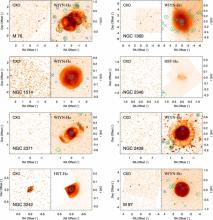
Abstract
We present an overview of the initial results from the Chandra Planetary Nebula Survey (CHANPLANS), the first systematic (volume-limited) Chandra X-Ray Observatory survey of planetary nebulae (PNe) in the solar neighborhood. The first phase of CHANPLANS targeted 21 mostly high-excitation PNe within ~1.5 kpc of Earth, yielding four detections of diffuse X-ray emission and nine detections of X-ray-luminous point sources at the central stars (CSPNe) of these objects. Combining these results with those obtained from Chandra archival data for all (14) other PNe within ~1.5 kpc that have been observed to date, we find an overall X-ray detection rate of ~70% for the 35 sample objects. Roughly 50% of the PNe observed by Chandra harbor X-ray-luminous CSPNe, while soft, diffuse X-ray emission tracing shocks—in most cases, "hot bubbles"—formed by energetic wind collisions is detected in ~30%; five objects display both diffuse and point-like emission components. The presence (or absence) of X-ray sources appears correlated with PN density structure, in that molecule-poor, elliptical nebulae are more likely to display X-ray emission (either point-like or diffuse) than molecule-rich, bipolar, or Ring-like nebulae. All but one of the point-like CSPNe X-ray sources display X-ray spectra that are harder than expected from hot (~100 kK) central stars emitting as simple blackbodies; the lone apparent exception is the central star of the Dumbbell nebula, NGC 6853. These hard X-ray excesses may suggest a high frequency of binary companions to CSPNe. Other potential explanations include self-shocking winds or PN mass fallback. Most PNe detected as diffuse X-ray sources are elliptical nebulae that display a nested shell/halo structure and bright ansae; the diffuse X-ray emission regions are confined within inner, sharp-rimmed shells. All sample PNe that display diffuse X-ray emission have inner shell dynamical ages <~ 5 × 103 yr, placing firm constraints on the timescale for strong shocks due to wind interactions in PNe. The high-energy emission arising in such wind shocks may contribute to the high excitation states of certain archetypical "hot bubble" nebulae (e.g., NGC 2392, 3242, 6826, and 7009).